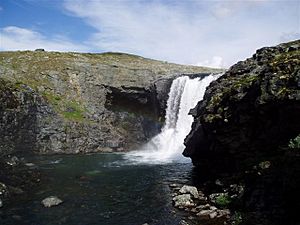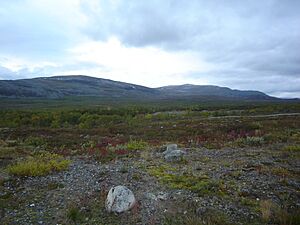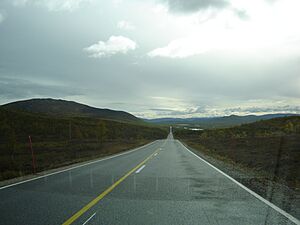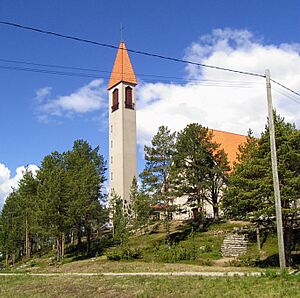Enontekiö facts for kids
Quick facts for kids
Enontekiö
|
||
|---|---|---|
|
Municipality
|
||
| Enontekiön kunta (Finnish) Eanodaga gielda (Northern Sami) Enontekis kommun (Swedish) |
||
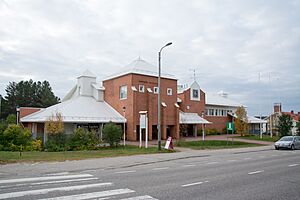 |
||
|
||
| Nickname(s):
Arm of Finland
|
||
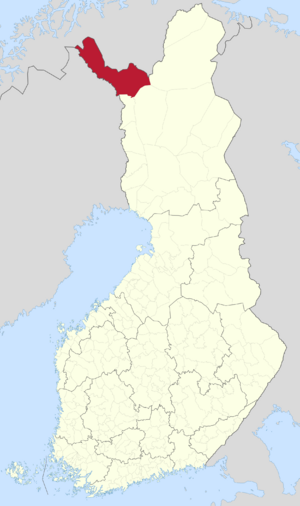
Location of Enontekiö in Finland
|
||
| Country | ||
| Region | Lapland | |
| Sub-region | Fell Lapland | |
| Founded (parish) | 1747 | |
| Charter | 1877 | |
| Seat | Hetta | |
| Area
(2018-01-01)
|
||
| • Total | 8,391.35 km2 (3,239.92 sq mi) | |
| • Land | 7,953.42 km2 (3,070.83 sq mi) | |
| • Water | 445.84 km2 (172.14 sq mi) | |
| Area rank | 4th largest in Finland | |
| Population
(2023-12-31)
|
||
| • Total | 1,771 | |
| • Rank | 268th largest in Finland | |
| • Density | 0.22/km2 (0.6/sq mi) | |
| 1 | ||
| Population by native language | ||
| • Finnish | 85.6% (official) | |
| • Swedish | 0.8% | |
| • Sami | 10.3% | |
| • Others | 3.3% | |
| Population by age | ||
| • 0 to 14 | 12.5% | |
| • 15 to 64 | 58.3% | |
| • 65 or older | 29.2% | |
| Time zone | UTC+02:00 (EET) | |
| • Summer (DST) | UTC+03:00 (EEST) | |
| Website | www.enontekio.fi | |
Enontekiö (pronounced "eh-non-TEH-kee-oh") is a small town in the Finnish part of Lapland. It has about 2,000 people living there. It's located in the very northwest corner of Finland, right between the borders of Sweden and Norway.
Enontekiö is a huge area, but not many people live there. Finland's highest point, a mountain called Halti, is in Enontekiö. It's 1,324 meters (about 4,344 feet) tall! The main village in Enontekiö is Hetta. About one-fifth of the people living here are Sami people, who are the native people of this region. The main jobs in Enontekiö are tourism and reindeer farming.
Contents
Exploring Enontekiö's Geography
Where is Enontekiö Located?
Enontekiö is found in the far northwest tip of Lapland, Finland. This part of Finland, which Enontekiö covers, is shaped like an arm. People call it Käsivarsi, which means "arm" in Finnish. This is because before World War II, Finland's map looked like a woman's figure, and this area was like her raised right arm.
Enontekiö is very large, covering about 8,391 square kilometers (3,240 sq mi). This makes it Finland's third-largest town by size. But it's also one of the most empty places, with very few people living per square kilometer.
Enontekiö shares borders with other Finnish towns like Inari, Kittilä, and Muonio. It also borders Kiruna in Sweden and Storfjord, Kåfjord, Nordreisa, and Kautokeino in Norway. The border with Sweden is formed by the Muonionjoki river.
Villages in Enontekiö
The main village in Enontekiö is Hetta, located in the south. About 530 people live there. Even though the town is called Enontekiö, there isn't a village with that name. Hetta is often thought of as the center of the municipality.
Other important villages include Kilpisjärvi, which is close to where Finland, Sweden, and Norway meet. Karesuvanto and Palojoensuu are also important, located along the Muonionjoki river near the Swedish border. Many villages in Enontekiö are in the southern part or along the rivers. The areas away from the rivers are mostly empty.
Here are some of the villages in Enontekiö (with their Sami names if they have one):
- Hetta (Heahttá)
- Jatuni (Jáhton)
- Karesuvanto (Gárasavvon)
- Kelottijärvi (Gelojávri)
- Ketomella
- Kilpisjärvi (Gilbbesjávri)
- Kultima (Gulddán)
- Kuttanen (Guhttás)
- Leppäjärvi (Leaibejávri)
- Luspa (Luspi)
- Markkina (Boaresmárkan)
- Maunu (Mávdna)
- Muotkajärvi (Muotkejávri)
- Näkkälä (Neahčil)
- Nartteli
- Nunnanen (Njunnás)
- Palojärvi (Bálojávri)
- Palojoensuu (Bálojohnjálbmi)
- Peltovuoma (Bealdovuopmi)
- Raittijärvi
- Ropinsalmi
- Saivomuotka (Sáivomuotki)
- Sonkamuotka
- Vähäniva
- Vuontisjärvi (Vuottesjávri)
- Yli-Kyrö
Mountains and Water
Enontekiö is very different from the rest of Finland because it's so far north and has mountains. It shares borders with parts of the Scandinavian Mountains in Sweden and Norway. Halti, Finland's highest mountain, is here. All 21 of Finland's mountains taller than 1,000 meters (3,280 feet) are in Enontekiö. Another famous mountain is Saana, which is 1,029 meters (3,376 feet) tall and stands over Kilpisjärvi village.
The southern part of Enontekiö has fewer mountains. But there are still some tall hills called tunturi (meaning "hills above the tree line").
About 5% of Enontekiö is covered by water. Many big rivers start here, like the Muonionjoki, Ounasjoki, Ivalojoki, and a branch of the Tenojoki. The name Enontekiö comes from these rivers. Eno is an old Finnish word for "major river," and tekiö comes from a Sami word meaning "large river." All 825 lakes in the area are quite small. The biggest lakes are Pöyrisjärvi, Kilpisjärvi, and Ounasjärvi near Hetta.
Plants and Animals
The plants in Enontekiö are not very thick because it's so far north. Spruce trees don't grow much further north than the southern border of Enontekiö. Pine trees stop growing about 20 kilometers (12 miles) north of Hetta. North of that, you'll mostly see birch trees.
Above about 600 meters (2,000 feet), trees can't grow at all. This area is like a tundra, with low-growing plants. You'll find shrubs like dwarf birch and blueberries. Higher up, there are small willows, mosses, and lichens.
Most of Enontekiö is made up of these open plateaus or wet bogs. Only 19% of the area is covered by forests. About 70% of Enontekiö is protected land, like parts of the Pallas-Yllästunturi National Park and other wilderness areas.
Because of the cold weather, there aren't many different kinds of animals. But you can find Arctic animals that don't live in southern Finland. These include the Norway lemming, Arctic fox, snowy owl, and ptarmigan. Besides the semi-tamed reindeer, there are many small mammals and birds.
Enontekiö's Climate
Enontekiö's weather is very cold because it's so far north and high up. It's also close to the Arctic Ocean. Even though the Gulf Stream makes winters a bit milder than in central Lapland, summers are shorter and cooler.
Enontekiö has the lowest average temperatures in Finland. In Kilpisjärvi, the average temperature is about -2.3°C (27.9°F). July is the warmest month, averaging 10.9°C (51.6°F), and January is the coldest, at -13.6°C (7.5°F). The growing season for plants is only about 100 days long. Winters are very long, lasting about 200 days.
It snows a lot here. The deepest snow ever recorded in Finland was in Kilpisjärvi on April 19, 1997, at 190 centimeters (75 inches)! Snow usually covers the ground from October until the end of May. Sometimes, snow stays even longer, and people can ski in Kilpisjärvi during Midsummer's night.
Enontekiö is about 200 to 300 kilometers (124 to 186 miles) north of the Arctic Circle. This means the amount of daylight changes a lot during the year. In Kilpisjärvi, the sun never sets between May 22 and July 23. This is called the Midnight Sun. In winter, from December 2 to January 11, the sun never rises. This is called Polar night (kaamos).
Enontekiö is also one of the best places in Finland to see the Northern Lights. In Kilpisjärvi, you can often see this amazing natural light show on three out of four clear nights during the dark season.
| Climate data for Enontekiö Kilpisjärvi kyläkeskus (1991–2020 normals, extremes 1979- present) | |||||||||||||
|---|---|---|---|---|---|---|---|---|---|---|---|---|---|
| Month | Jan | Feb | Mar | Apr | May | Jun | Jul | Aug | Sep | Oct | Nov | Dec | Year |
| Record high °C (°F) | 6.2 (43.2) |
6.4 (43.5) |
8.2 (46.8) |
12.7 (54.9) |
26.1 (79.0) |
26.6 (79.9) |
28.3 (82.9) |
26.7 (80.1) |
20.2 (68.4) |
12.9 (55.2) |
9.4 (48.9) |
6.8 (44.2) |
28.3 (82.9) |
| Mean maximum °C (°F) | 2.1 (35.8) |
2.1 (35.8) |
3.6 (38.5) |
7.5 (45.5) |
14.0 (57.2) |
20.3 (68.5) |
23.0 (73.4) |
21.4 (70.5) |
16.1 (61.0) |
9.1 (48.4) |
4.2 (39.6) |
3.4 (38.1) |
24.1 (75.4) |
| Mean daily maximum °C (°F) | −7.7 (18.1) |
−7.9 (17.8) |
−4.2 (24.4) |
0.9 (33.6) |
6.2 (43.2) |
12.2 (54.0) |
16.2 (61.2) |
14.3 (57.7) |
9.1 (48.4) |
2.0 (35.6) |
−3.2 (26.2) |
−5.8 (21.6) |
2.7 (36.9) |
| Daily mean °C (°F) | −12.2 (10.0) |
−12.3 (9.9) |
−8.8 (16.2) |
−3.5 (25.7) |
2.3 (36.1) |
7.7 (45.9) |
11.6 (52.9) |
10.1 (50.2) |
5.7 (42.3) |
−0.5 (31.1) |
−6.5 (20.3) |
−10.1 (13.8) |
−1.4 (29.5) |
| Mean daily minimum °C (°F) | −17.3 (0.9) |
−17.4 (0.7) |
−14.1 (6.6) |
−8.3 (17.1) |
−1.4 (29.5) |
3.8 (38.8) |
7.9 (46.2) |
6.8 (44.2) |
2.9 (37.2) |
−3.0 (26.6) |
−10.0 (14.0) |
−14.7 (5.5) |
−5.4 (22.3) |
| Mean minimum °C (°F) | −33.0 (−27.4) |
−32.1 (−25.8) |
−29.1 (−20.4) |
−22.8 (−9.0) |
−9.6 (14.7) |
−0.8 (30.6) |
2.7 (36.9) |
0.7 (33.3) |
−3.1 (26.4) |
−11.7 (10.9) |
−22.3 (−8.1) |
−29.3 (−20.7) |
−36.0 (−32.8) |
| Record low °C (°F) | −40.2 (−40.4) |
−41.0 (−41.8) |
−37.7 (−35.9) |
−31.0 (−23.8) |
−22.0 (−7.6) |
−4.2 (24.4) |
−0.7 (30.7) |
−1.9 (28.6) |
−8.5 (16.7) |
−24.0 (−11.2) |
−34.6 (−30.3) |
−39.1 (−38.4) |
−41.0 (−41.8) |
| Average precipitation mm (inches) | 52 (2.0) |
39 (1.5) |
37 (1.5) |
27 (1.1) |
28 (1.1) |
49 (1.9) |
73 (2.9) |
50 (2.0) |
38 (1.5) |
37 (1.5) |
36 (1.4) |
49 (1.9) |
516 (20.3) |
| Average precipitation days | 11 | 10 | 8 | 6 | 7 | 8 | 10 | 8 | 8 | 9 | 9 | 11 | 105 |
| Source 1: FMI climatological normals for Finland 1991-2020 | |||||||||||||
| Source 2: Record highs and lows 1979- present | |||||||||||||
Enontekiö's History
Early Times and Swedish Rule
The first people came to Enontekiö after the ice age, about 6,000 years BC. They were hunters and fishers. Later, the Sami people developed from these early groups and other people who arrived. The Sami originally hunted and fished, using a few reindeer to help them.
In the 1500s, Enontekiö came under Swedish influence as Christianity spread. The first church was built in Rounala (now in Sweden). It was a key place for Sami people to meet, pray, and trade. A new church was built in Markkina in 1611, and again in 1661 after it was destroyed.
By the late 1600s, keeping large herds of reindeer became common. The reindeer-Sami people of Enontekiö were nomads. They moved with their reindeer between the forests in the south and the Arctic coast in Norway, following where the reindeer could find food. The last nomads settled down in the 1960s, but reindeer herding is still a big part of their culture. Around the 1600s, the first Finnish people also started to settle in southern Enontekiö, bringing farming. Over time, more Finns moved in, and the Sami people blended in, leading to a Finnish majority.
Under Russian Rule
In 1809, Sweden gave Finland to Russia, and Enontekiö became part of the new Grand Duchy of Finland. The church in Markkina was on the wrong side of the new border, so it was taken down in 1826. Its wood was used to rebuild the church in Palojoensuu, and later in Hetta in 1864, which had become the biggest village.
In the late 1800s, the borders with Norway (1852) and Sweden (1889) were closed. This made it hard for reindeer nomads to move their herds to the coast. So, they moved their grazing areas inland, spreading reindeer herding to other parts of Lapland. In 1877, Enontekiö officially became its own town, separate from the church.
After Finland Became Independent
Finland became an independent country in 1917, and Enontekiö was part of it.
During the Continuation War (1941–1944), Finland fought alongside Germany against the Soviet Union. Enontekiö was an important area for the German army. In 1942, the Germans built a strong defense line called the Sturmbock emplacement to protect harbors on the Arctic Ocean.
When Finland made peace with the Soviet Union in 1944, they had to make the German troops leave. This started the Lapland War. People living in Lapland had to quickly move to safety. Enontekiö's people were sent to neutral Sweden. The Germans used a "scorched earth" tactic, destroying much of Enontekiö as they retreated.
Finnish and German troops fought in the cold winter. By early 1945, the Sturmbock emplacement was no longer important, and the Germans left it. The last German soldiers left Finland on April 27, 1945, near Kilpisjärvi.
People of Enontekiö
Population Changes
Enontekiö currently has almost 2,000 people. In the early 1990s, there were about 2,500. During a tough economic time in Finland, many people moved from Lapland to bigger cities in the south. Enontekiö's population dropped quickly at first, but it has now stayed steady at a lower number.
About 13% of Enontekiö's people are under 15 years old. About 62% are between 15 and 64, and about 25% are older than 64. There are slightly more men than women, with men making up 53.2% of the population.
| Year | 1980 | 1985 | 1990 | 1995 | 1996 | 1997 | 1998 | 1999 | 2000 | 2001 | 2002 | 2003 | 2004 | 2005 | 2006 |
|---|---|---|---|---|---|---|---|---|---|---|---|---|---|---|---|
| Inhabitants | 2,286 | 2,415 | 2,472 | 2,413 | 2,378 | 2,365 | 2,324 | 2,225 | 2,145 | 2,100 | 2,073 | 2,022 | 1,998 | 2,000 | 1,997 |

The Sami People
Enontekiö is part of the traditional home of the Sami people, who are the native people of this region. About 19% of the people in Enontekiö are Sami. However, only about 10% speak Sami as their first language.
Enontekiö is in the Sami "homeland" area, which means Sami people have special rights here. For example, Northern Sami, the Sami language spoken in Enontekiö, is an official language alongside Finnish. This means people can use Sami when talking to local government offices. Famous Sami people from Enontekiö include artist Nils-Aslak Valkeapää and Joik-singer Wimme.
Religion in Enontekiö
Most people in Enontekiö belong to the Evangelical Lutheran Church of Finland. The local church is part of the parish of Enontekiö. It became its own parish in 1916.
A conservative Lutheran movement called Laestadianism is also strong here, like in other parts of Lapland. The founder of Laestadianism, Lars Levi Laestadius, was a pastor in nearby Karesuando, Sweden, from 1826 to 1849. His teachings quickly spread to Enontekiö.
Jobs and Services in Enontekiö
What Do People Do for Work?
Most jobs in Enontekiö are in the service industry, like working for the government or in shops. About 76% of working people are in services. About 13% work in farming and forestry, and 6% work in manufacturing.
Unemployment is a challenge in Lapland, including Enontekiö. In January 2007, about 24.7% of people were unemployed. This was the second highest rate in Finland at the time.
Reindeer husbandry (reindeer farming) has been very important in Enontekiö for a long time. Unlike other parts of Finland, reindeer farming has been done here for centuries. Today, reindeer herders work together in groups called paliskunta. They manage about 20,000 semi-tamed reindeer.
Farming is difficult because of the cold climate, but some small-scale dairy farming exists. Forestry is also not a big industry because there aren't many dense forests.
Tourism in Enontekiö
Tourism is a major business in Enontekiö. While it doesn't have huge ski resorts like some other Lapland towns, it attracts nature lovers. People come here for hiking, fishing, canoeing, skiing, and snowmobiling. It's also a stop for people driving to the North Cape.
More than 100,000 overnight stays are recorded each year. About 20% of visitors are from other countries. Norwegians are the largest group, often visiting to shop because prices are lower in Finland. Norwegian shopping makes up a large part of the retail business in Enontekiö, especially in Kilpisjärvi near the border.
Getting Around Enontekiö
The most important road in Enontekiö is Highway 21 (E8). It runs along the Finnish-Swedish border from Tornio to Kilpisjärvi, where it meets the Norwegian border. Main Road 93 branches off Highway 21 at Palojoensuu. It goes east to Hetta, then north to the Norwegian border.
Smaller roads connect the villages in the southern part of Enontekiö. But in the northern part, Highway 21 is the only road. The empty area between the river valley and the Norwegian border has no roads at all. There are three border crossings in Enontekiö: one bridge to Sweden at Karesuvanto, and two crossings to Norway at Kilpisjärvi and Kivilompolo.
Enontekiö has its own airport, Enontekiö Airport, near Hetta. Most flights are charters, especially in spring. The company Finncomm Airlines offers direct flights from Helsinki-Vantaa between March and May. The airport has about 13,700 passengers per year.
Enontekiö does not have a train station. The closest one is in Kolari, about 150 kilometers (93 miles) south.
Schools and Healthcare
Enontekiö has five primary schools. In Kilpisjärvi, students go from preschool to 9th grade. In Karesuvanto, Hetta, and Peltojärvi, they go from preschool to 6th grade. Enontekiö's upper school is for grades 7 to 9. After upper school, students can go to the secondary school in Enontekiö to prepare for higher education.
The primary schools in Kilpisjärvi and Karesuvanto, and the upper school in Enontekiö, offer education in the Sami language for Sami students. Adults can also take classes at an adult education center. The main library is in Hetta, and a mobile library visits more remote areas. The University of Helsinki has a research station in Kilpisjärvi, and the University of Oulu runs the KAIRA radio telescope facility there.
Healthcare services are shared with the nearby town of Muonio. Enontekiö has two health centers for patient care, one in Hetta and one in Karesuvanto. More beds for patients are available at Muonio's health center.
Culture and Things to See
Important Buildings
The church of Enontekiö is in the main village of Hetta. It was built in 1951-1952 after the previous one was destroyed during the Lapland War. It's the sixth church for the town. It's a modern building made of brick and concrete, designed by Veikko Larkas. The tall, thin church tower is 30 meters (98 feet) high and is connected to the main church building.
The artist Uuno Eskola created the altarpiece for the church. It shows Jesus Christ blessing Lapland and its people. The church's organ was a gift from Germany in 1958.
Several villages, like Kultima, Näkkälä, Nunnanen, Peltovuoma, Pöyrisjärvi, and Raittijärvi, are officially protected because they have old, well-preserved buildings. The stone bridge of Ahdaskuru, built in 1943 near the Norwegian border, is also protected. It's the only bridge in Lapland that wasn't destroyed during the Lapland War.
Museums to Visit
Enontekiö has three museums. The local history museum, opened in 1991, has old buildings moved from different villages. These include a farmhouse from the late 1800s, a living room from the 1920s, and an 18th-century storehouse.
The Fjell-Lapland nature and culture center is also in Hetta. It has exhibits about the nature of northern Lapland and the culture of the reindeer-Sami people.
In Järämä, about 20 kilometers (12 miles) north of Karesuvanto, part of the Sturmbock emplacement from the Lapland War has been rebuilt. Since 1997, there's a museum there that tells the story of the Lapland War in Enontekiö.
Fun Events and Festivals
Since 1971, a Sami cultural event called Mary's Days of Hetta (Hetan Marianpäivät) is held in early March. It continues an old Sami tradition of meeting in the church village on special holidays. Today, Mary's Days includes Sami music, art shows, and contests like reindeer sleigh riding.
At Easter, a church and chamber music festival, the Music Days of Hetta (Hetan musiikkipäivät), takes place. From late April to early May, a big ice fishing contest (Kilpisjärven pilkkiviikot) attracts many fishermen. In late summer, there's an orienteering tournament (Suomen tunturisuunnistus) on the fells near Kilpisjärvi.
Famous People from Enontekiö
- Andte Gaupe-Juuso, winner of Big Brother in 2014
- Kai Hyttinen, musician
- Anni-Kristiina Juuso, actress
- Aslak Juuso, a reindeer herder
- Pigga Keskitalo, Sami politician and academic
- Yrjö Kokko, writer
- Ilmari Mattila, actress
- Juhani Raattamaa, a "lay preacher"
- Wimme Saari, singer
- Nils-Aslak Valkeapää, writer, artist, and musician
- Niko Valkeapää, musician
- Vuontis-Kalle, storyteller
Images for kids
See also
 In Spanish: Enontekiö para niños
In Spanish: Enontekiö para niños




